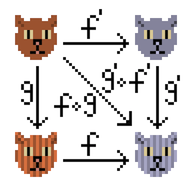Monad
Monad extends the Applicative type class with a
new function flatten. Flatten takes a value in a nested context (eg.
F[F[A]] where F is the context) and "joins" the contexts together so
that we have a single context (ie. F[A]).
The name flatten should remind you of the functions of the same name on many
classes in the standard library.
scala> Option(Option(1)).flatten
res0: Option[Int] = Some(1)
scala> Option(None).flatten
res1: Option[Nothing] = None
scala> List(List(1),List(2,3)).flatten
res2: List[Int] = List(1, 2, 3)
Monad instances
If Applicative is already present and flatten is well-behaved,
extending the Applicative to a Monad is trivial. To provide evidence
that a type belongs in the Monad typeclass, cats' implementation
requires us to provide an implementation of pure (which can be reused
from Applicative) and flatMap.
We can use flatten to define flatMap: flatMap is just map
followed by flatten. Conversely, flatten is just flatMap using
the identity function x => x (i.e. flatMap(_)(x => x)).
scala> import cats._
import cats._
scala> implicit def optionMonad(implicit app: Applicative[Option]) =
| new Monad[Option] {
| // Define flatMap using Option's flatten method
| override def flatMap[A, B](fa: Option[A])(f: A => Option[B]): Option[B] =
| app.map(fa)(f).flatten
| // Reuse this definition from Applicative.
| override def pure[A](a: A): Option[A] = app.pure(a)
| }
optionMonad: (implicit app: cats.Applicative[Option])cats.Monad[Option]
flatMap
flatMap is often considered to be the core function of Monad, and cats
follows this tradition by providing implementations of flatten and map
derived from flatMap and pure.
scala> implicit val listMonad = new Monad[List] {
| def flatMap[A, B](fa: List[A])(f: A => List[B]): List[B] = fa.flatMap(f)
| def pure[A](a: A): List[A] = List(a)
| }
listMonad: cats.Monad[List] = $anon$1@58491bc5
Part of the reason for this is that name flatMap has special significance in
scala, as for-comprehensions rely on this method to chain together operations
in a monadic context.
scala> import scala.reflect.runtime.universe
import scala.reflect.runtime.universe
scala> universe.reify(
| for {
| x <- Some(1)
| y <- Some(2)
| } yield x + y
| ).tree
res3: reflect.runtime.universe.Tree = Some.apply(1).flatMap(((x) => Some.apply(2).map(((y) => x.$plus(y)))))
ifM
Monad provides the ability to choose later operations in a sequence based on
the results of earlier ones. This is embodied in ifM, which lifts an if
statement into the monadic context.
scala> Monad[List].ifM(List(true, false, true))(List(1, 2), List(3, 4))
res4: List[Int] = List(1, 2, 3, 4, 1, 2)
Composition
Unlike Functors and Applicatives,
not all Monads compose. This means that even if M[_] and N[_] are
both Monads, M[N[_]] is not guaranteed to be a Monad.
However, many common cases do. One way of expressing this is to provide
instructions on how to compose any outer monad (F in the following
example) with a specific inner monad (Option in the following
example).
scala> case class OptionT[F[_], A](value: F[Option[A]])
defined class OptionT
scala> implicit def optionTMonad[F[_]](implicit F : Monad[F]) = {
| new Monad[OptionT[F, ?]] {
| def pure[A](a: A): OptionT[F, A] = OptionT(F.pure(Some(a)))
| def flatMap[A, B](fa: OptionT[F, A])(f: A => OptionT[F, B]): OptionT[F, B] =
| OptionT {
| F.flatMap(fa.value) {
| case None => F.pure(None)
| case Some(a) => f(a).value
| }
| }
| }
| }
optionTMonad: [F[_]](implicit F: cats.Monad[F])cats.Monad[[β]OptionT[F,β]]
This sort of construction is called a monad transformer.
